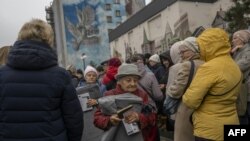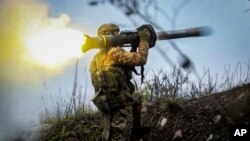Ukrainian authorities in Kyiv are warning of a “complete shutdown,” as subzero temperatures are gripping the country.
In an interview with The Associated Press, the city’s mayor, Vitali Klitschko, said authorities are attempting to restore the city’s power grid.
Russian strikes have inflicted heavy damage on the energy grid of the Ukrainian capital while they continue to barrage Ukraine in multiple parts of the country — from the capital city, Kyiv, in the north to Odesa in the south — crushing almost half of Ukraine’s energy system, Ukrainian Prime Minister Denys Shmyhal said.
"Unfortunately, Russia continues missile strikes against the civilian critical infrastructure of Ukraine, fighting against the civilian population and depriving them of light, water supply, heat and communications during the winter.” His comments came during talks with European Commission Vice President Valdis Dombrovskis in Kyiv.
The Ukrainian prime minister added that, “On November 15, Russia fired about 100 missiles at Ukrainian cities. Almost half of our energy systems have been disabled."
Amid freezing temperatures, about 10 million people in the country have been left without power and heat, Ukrainian President Volodymyr Zelenskyy said Thursday in his nightly video address.
The Ukrainian president said people are experiencing blackouts and outages in 18 regions, as well as in Kyiv, and he added that utility workers are doing “everything to restore electricity.
The chief executive of state utility operator Ukrenergo, Volodymyr Kudrytskyi, said on Ukrainian state television, “We need to prepare for possible long outages, but at the moment we are introducing schedules that are planned and will do everything to ensure that the outages are not very long.”
A United Nations agency said it feared a humanitarian crisis this winter if the power outages continued.
Russia's defense ministry said its strikes in Ukraine on Thursday were aimed at military and energy infrastructure, Russian news agencies reported. It said it used long-range weapons to hit defense and industrial targets, including "missile manufacturing facilities.”
Meanwhile on Friday, Zelenskyy also met with Dombrovskis in Kyiv, and thanked him for the EU’s planned financial assistance program of more than $18.5 billion in 2023.
Ukraine reports shelling, missiles nationwide
In the northeastern Kharkiv region, overnight shelling and missile strikes targeted “critical infrastructure” and damaged energy equipment, according to regional governor Oleh Syniehubov. Eight people, including energy company crews and police officers, were injured while trying to clear some of the debris, he said.
Russian forces employed drones, rockets, heavy artillery and warplanes in Ukraine’s southeast, resulting in the deaths of at least six civilians and wounding an equal number in the past 24 hours, the office of the president reported.
In the Zaporizhzhia region, part of which remains under Russian control, heavy fire targeted 10 towns and villages. The death toll from a rocket attack Thursday on a residential building in the city of Vilniansk climbed to nine people, the deputy head of Ukraine’s presidential office, Kyrylo Tymoshenko, posted on Telegram.
In Nikopol, located across the Dnipro River from the Zaporizhzhia Nuclear Power Plant, 40 Russian missiles damaged several high-rise buildings, private houses, and a power line.
In the Donetsk region in eastern Ukraine, Russia was using troops pulled from Kherson to unleash heavy attacks. The Ukrainian military said Russian forces fired artillery on the towns of Bakhmut and nearby Soledar, among others.
In Luch, a village that sits on the border between the Mykolaiv and Kherson regions, months of Russian shelling have turned the locality into a virtual ghost town. Before February 24, about 1,000 people lived in the village. Now just 38 remain.
Hundreds detained, missing in Kherson
A Yale University report backed by the U.S. State Department reveals that 226 people were detained or disappeared between March and October during Russia’s occupation of Kherson.
The Conflict Observatory, a Yale university research program supported by the U.S. State Department, released its independent report Friday. It describes numerous instances of unjust detentions and disappearances in Kherson. “Russia must halt these operations and withdraw its forces to end a needless war that it cannot and will not win — no matter how despicable and desperate its tactics,” a State Department statement announced Friday.
Investigators in liberated areas of the Kherson region have uncovered 63 bodies bearing marks of what appeared to have been torture, Ukraine Interior Minister Denys Monastyrsky was quoted as saying.
The Ukrainian parliament's human rights commissioner, Dmytro Lubinets, released a video of what he said was a torture chamber used by Russian forces in the Kherson region.
Lubinets said Russians tortured Ukrainians with electric current, broke their bones, beat them with metal pipes, and killed them. He noted the invaders recorded all their crimes on video.
In the video, Lubinets speaks from a series of underground rooms he says were used for detentions, interrogations and torture. Electric shocks were used to secure confessions, he said.
Reuters was unable to verify the allegations made by Lubinets and others in the video. Russia denies its troops deliberately attack civilians or have committed atrocities.
Meanwhile, Russia claimed Friday that Ukrainian soldiers executed more than 10 Russian prisoners of war, accusing Kyiv of war crimes and the West of ignoring them.
The Russian defense ministry cited a video circulating on Russian social media that it alleged showed the execution of Russian prisoners of war. Reuters was unable to immediately verify either the video or the defense ministry's assertions.
Yelyzaveta Krotyk contributed to this report. Some information for this report came from Agence France-Presse, Reuters and The Associated Press.








